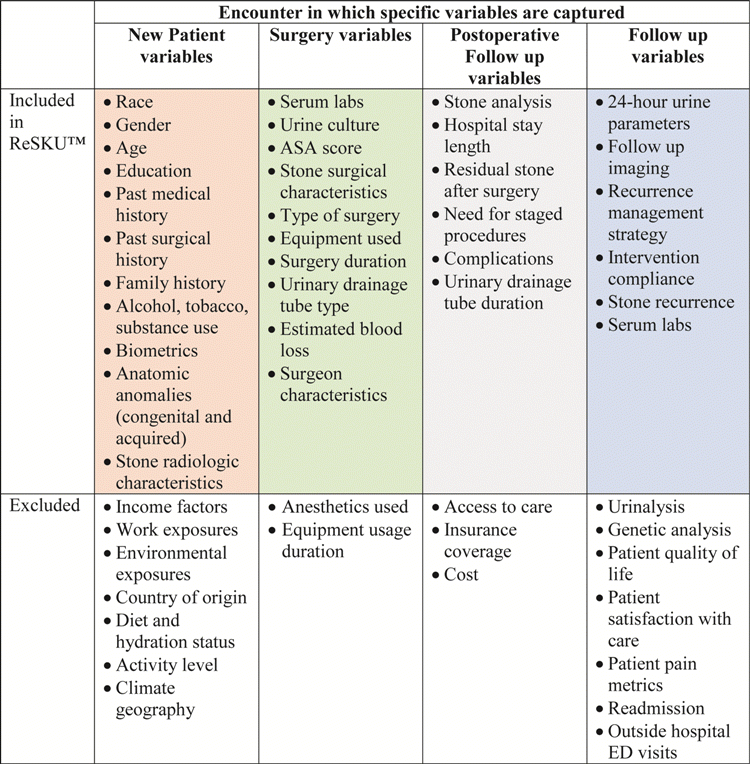| Patient Variables Associated with Early Versus Late Stone Formation | ||
|---|---|---|
| Odds Ratio | Confidence Interval (2.5–97.5%) | |
| Gender (Female) | 2.03 | 1.17–3.54 |
| Race (Non-caucasian) | 0.83 | 0.46–1.47 |
| BMI > 30 | 0.51 | 0.26–0.94 |
| Family History of Nephrolithiasis | 0.94 | 0.54–1.63 |
| Infectious symptoms on Presentation | 1.46 | 0.68–2.97 |
| More than 1 prior stone episode | 2.02 | 1.13–3.78 |
Patient variable associated with early stone formation. Multivariate analysis of associated patient factors comparing early vs late recurrent stone formers. Increased odds ratio indicates association with early stone former group. Statistically significant confidence intervals (p < 0.05) noted in bold.
Stone formation in patients less than 20 years of age is associated with higher rates of stone recurrence: Results from the Registry for Stones of the Kidney and Ureter (ReSKU).
Li, Y., Bayne, D., Wiener, S., Ahn, J., Stoller, M., & Chi, T. (2020)
Journal of pediatric urology, 16(3), 373.e1–373.e6. https://doi.org/10.1016/j.jpurol.2020.03.014

FIG. 2. Suggested profiles to aid the surgical management of patients with CSD >20 mm. A majority of patients in Profile 1, who had more than three stones and relatively low burden (<35 mm), were managed with URS. Patients in Profile 2, who had two to three stones and low burden, were split between URS and PCNL. A majority of patients in Profile 3, who had one stone or relatively high burden (>35 mm), were managed with PCNL. PCNL = percutaneous nephrolithotomy.
The Impact of Stone Multiplicity on Surgical Decisions for Patients with Large Stone Burden: Results from ReSKU.
Zetumer, S., Wiener, S., Bayne, D. B., Armas-Phan, M., Washington, S. L., 3rd, Tzou, D. T., Stoller, M., & Chi, T. (2019).
Journal of endourology, 33(9), 742–749. https://doi.org/10.1089/end.2019.0130

FIG. 1. In this dot plot, each dot depicts a CT scan performed during the study period. For any given subject, each black dotrepresents a scan that either by itself or in combination with other scans, contributed to that subject's maximum effective dose exceeding the 50 mSv threshold within a 12-month period.
Computed Tomography Radiation Exposure Among Referred Kidney Stone Patients: Results from the Registry for Stones of the Kidney and Ureter.
Tzou, D. T., Zetumer, S., Usawachintachit, M., Taguchi, K., Bechis, S. K., Duty, B. D., Harper, J. D., Hsi, R. S., Sorensen, M., Sur, R. L., Reliford-Titus, S., Chang, H. C., Isaacson, D., Bayne, D. B., Wang, Z. J., Stoller, M. L., & Chi, T. (2019).
Journal of endourology, 33(7), 619–624. https://doi.org/10.1089/end.2019.0091

Figure 1 Scatter Plots of Urologic and Radiologic Aggregate Stone Size
Variation in Radiologic and Urologic Computed Tomography Interpretation of Urinary Tract Stone Burden: Results From the Registry for Stones of the Kidney and Ureter.
Tzou, D. T., Isaacson, D., Usawachintachit, M., Wang, Z. J., Taguchi, K., Hills, N. K., Hsi, R. S., Sherer, B. A., Reliford-Titus, S., Duty, B., Harper, J. D., Sorensen, M., Sur, R. L., Stoller, M. L., & Chi, T. (2018).
Urology, 111, 59–64. https://doi.org/10.1016/j.urology.2017.10.002
Table 2. Variables Considered for Inclusion in the Registry

Data points listed demonstrate conceptualizing the determinants of stone patient outcomes. Included variables in bold are readily collected as part of each patient clinical encounter.
ASA = American Society of Anesthesiologists; BMP = Basic metabolic panel; ReSKU™ = Registry for Stones of the Kidney and Ureter.
Rationale and Design of the Registry for Stones of the Kidney and Ureter (ReSKU): A Prospective Observational Registry to Study the Natural History of Urolithiasis Patients.
Chang, H. C., Tzou, D. T., Usawachintachit, M., Duty, B. D., Hsi, R. S., Harper, J. D., Sorensen, M. D., Stoller, M. L., Sur, R. L., & Chi, T. (2016).
Journal of endourology, 30(12), 1332–1338. https://doi.org/10.1089/end.2016.0648
See Publications for additional ReSKU research